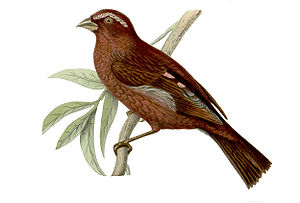Burgundy bullfinch
| Burgundy bullfinch | ||||||||||||
|---|---|---|---|---|---|---|---|---|---|---|---|---|

Burgundy bullfinch, male |
||||||||||||
| Systematics | ||||||||||||
|
||||||||||||
| Scientific name | ||||||||||||
| Carpodacus vinaceus | ||||||||||||
| Verreaux , 1871 |
The burgundy bullfinch ( Carpodacus vinaceus ) or ruby bullfinch is a songbird from the finch family . The species inhabits the Himalayas from northern India to northern Myanmar , southwestern Tibet , central China and Taiwan . It breeds in dense mixed forests, damp bamboo forests , bushes and undergrowth.
description
Appearance
The Burgundy bullfinch is 13-16 cm long, about the same size as a chaffinch . This strikingly dark species of carmine has a high, rounded apex and a relatively long tail. The tail length is about 58 mm. The wing length is between 79 and 71 mm. The short, strong beak, the ridge of which and the edge of the lower beak bend almost symmetrically towards the tip, is dark brown or blackish in the male, and gray-brown in the female. The feet are dark horn brown.
The male Burgundy Bullfinch can be easily distinguished from other dark male carmine bulls such as the thin-billed bullfinch and the Edwardian bullfinch by its relatively inconspicuous head. The male bullfinch has a lighter underside. Differentiating the females is often much more difficult.
As with all representatives of the genus, there is a clear sexual dimorphism in the plumage. In the male, the upper side is dark red to the lower back, the rump is pink, and the upper tail-coverts are dark red again. The reins and the eye stripe are blackish, the relatively wide over-eye stripe is pink, begins just behind the forehead and extends to the sides of the neck, where it runs out. The underside is also dark red and sometimes appears lightly dashed due to dark feather centers. The chest is sometimes lighter, as is the under tail-coverts, which can be beige, sometimes showing pink tips. The wing plumage is black with reddish-pink edges. The umbrella feathers have a pinkish white field towards the tip on the outer flags. The slightly forked tail is also black with reddish brown edges.
The female is almost completely dark to warm earth brown with an olive tint on the top. Dark feather centers make the top of the head, neck and back appear slightly dashed up close. The rump is not drawn. The underside is a little lighter with a diffuse pattern, the lower abdomen and tail-coverts are undefined, warm beige-brown. The wing plumage is dark or black brown with lighter edges and tips. The field on the outer flags of the shield springs is yellowish-white to light beige. The control feathers are dark brown with fine beige borders.
The youth dress is similar to that of the female, but is tinted warmer on the top and slightly streaked overall. Young males show traces of a pink over-eye stripe early on and in some of them the light field on the umbrella feathers is missing.
voice
The call is a hard, powerful pwit or pull with the quality of a whip. It is sometimes repeated several times and often introduces the chant. In addition, a high, accentuated's tip and a faint tink , pink or a bunting like zig heard. The singing is a memorable pi-di bi-du that lasts about two seconds.
Distribution and geographic variation
The southeast Palearctic and Oriental distribution is divided into three sub-areas. One is in the Himalayas and extends from Uttar Pradesh through Nepal , which is sparsely populated by this species, and northern Myanmar to eastern Tibet. The second area extends from northwestern Yunnan and Gùizhōu through Sichuan northwards to the south of Gānsù and Shaanxi . The island of Taiwan is also from the subspecies C. v. formosana , which is slightly larger and darker than the nominate form.
- C. v. vinaceus Verreaux 1871 - Himalayas and China
- C. v. formosana Ogilvie-Grant , 1911 - Taiwan
The Burgundy bullfinch is usually rare or occurs scattered. He is common in Taiwan. According to the IUCN , it is not threatened.
Way of life
During the breeding season, the Burgundy bullfinch is found at altitudes between 1970 and 3400 m, in winter it descends at altitudes between 1065 and 3050 m. In Taiwan the species occurs at altitudes between 2280 and 2875 m.
The Burgundy bullfinch breeds in fairly dense mixed forests or in damp bamboo forests, as well as in bushes and shrubs on open slopes. You can find him individually or in small groups. It often sits inconspicuously in bushes or undergrowth for a long time. He looks for food in the lower shrub layer or on the ground. Little is known about the diet, presumably it feeds mainly on seeds, like other carmine pickles.
literature
- P. Clement, A. Harris, J. Davis: Finches and Sparrows , Helm Identification Guides, London 1993/1999, ISBN 0-7136-5203-9
Web links
- Carpodacus vinaceus in the endangered Red List species the IUCN 2009. Posted by: BirdLife International, 2009. Accessed on March 20 of 2010.
- Videos, photos and sound recordings of Carpodacus vinaceus in the Internet Bird Collection
- Photos for Carpodacus vinaceus in the Oriental Bird Club image database , accessed March 20, 2010
